 |
||
|
||
| ||
 At first sight, the camera continues a series started with the 2000-th camera, differing only in a lens with a 10x focal length. But after a careful examination, it is clear that they have not much in common, except a similar design of a case (it looks like that of film cameras). In construction the model reminds a video camera: it lacks for an optical viewfinder, but it is rational since it must be difficult to adjust with such a large lens. There are two viewfinders: one in the form of an LCD on the rear panel of the camera, and the other, also in the form of an LCD, is that which you look at in the eyepiece. The further examination shows that the flash is another feature that differs from our model from the 2000-th one (here we have a pop-up flash). Besides, neck strap eyelets are also absent. The only thing where you can fasten a small strap is an axle of a lid of the SmartMedia card compartment, but such solution doesn't seem reliable. We have managed to a fetch a camera number 3 without any other markings and description, that is why everything I give you here is taken from my own experience.  A switch button is located on the rear panel. When pressing it the lens is protruding from the transportation position to a working one, and the lid comes with it. After it, a focal length changes only at the expense of moving lenses. The dimensions of the lens barrel don't change in this case. On the case you can find a threading for, in my opinion, an adapter for installation of optical attachments. But a gap between the barrel mounted on the camera's case and the lens barrel is so little, that no standard rings would fit here. It seems that we need native OLYMPUS' rings. The camera can be connected only with a proprietary external flash FL-40 from OLYMPUS, since a connector is non-standard: it has five pins. The device perfectly suits both for those who are used to deal with a full automated camera and for those who prefer to control a shooting process entirely. There is a full manual control, shutter priority, aperture priority, manual focusing. A magnifier of a viewfinder has too strong magnification, since you can distinguish separate elements of an LC matrix. We eliminated it with another device. I wish the manufacturers have installed a black&white viewfinder with an electron-beam tube. Maybe it is not the optimal solution as far as power consumption is concerned, but it is much more convenient to work with. And if you need to estimate color transfer, then there is one more LCD on a rear panel. 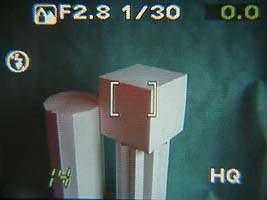 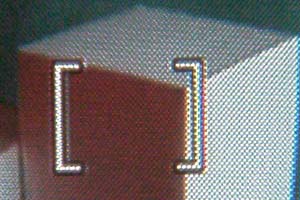 The camera connects to a computer via a USB connector. It can be used as a universal means for reading SmartMedia cards. That is, you can write and read any files, not only with images. Images are recorded in JPEG and TIFF. You can connect an external power supply source and a TV set. The camera is powered from 4 alkaline AA batteries (rechargeable ones are preferable), or two proprietary batteries from OLYMPUS - LB-01 CR-V3.   The menu navigation has both advantages and disadvantages of digital and film cameras. On the one hand, there is a wheel of fast mode switching for choosing different auto modes or a manual control. On the other hand, for choosing a shutter or aperture priority or manual control it is necessary to enter the menu.  The navigation is implemented both with a joystick on the rear panel or at the expense of pressing one key a definite time. Press quickly a key inside a mini-joystick and you will get into the menu. If you press and hold it, then you are in a focusing mode, and you can choose an auto mode or a manual one with a joystick. When switching it on, the display shows a distance from an object, and when implementing focusing an image is enlarged to get more sharper.  The camera allows for recording audio comments, and a video with sound. But you can listen to comments only after transferring data to a computer. While shooting a video you can't change a focal length. Some other cameras have no sound, but allows for changing a focal length. Tastes differ, however. TestsOn the whole, the camera is a very powerful tool. And the major problem facing the developers was how to make a good lens with a 10x focal length to make its defects unnoticeable on images. Today we have not a record for today 2 Mpixel matrix. In our tests we tried to find out what worsens the quality - the matrix or the lens. In case of an ideal for this matrix lens a resolution and a contrast of a resolution chart mustn't depend either on a lens focal length or on a position of a resolution chart in a frame. The shooting shows that the ideal is still too far. There are both chromatic aberrations and astigmatism. 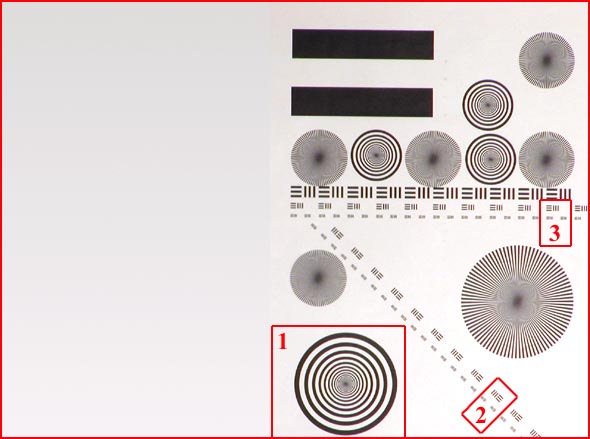 Test table. The shots were recorded in TIFF format. Such criterion as a modulation transfer function (MTF) is often used for estimation quality of a lens. The MTF is a dependence of a contrast in a lens image on a spatial frequency. The contrast is estimated according to the following formula: K= (Emax - Emin)/(Emax + Emin), where Emax and Emin are the maximum and minimal illumination of image elements. At the expense of aberration, diffraction, imperfection of optical and mechanical parts of a lens an image contrast lowers. With an increase of a spatial frequency the contrast lowers until an image gets gray without any differences between black and while lines. The MTF allows for a continuous control of resolution and contrast. We have shot a resolution chart which consists of concentric black and white rings of different width (1). Each next ring is 0.9 narrower than a previous one. 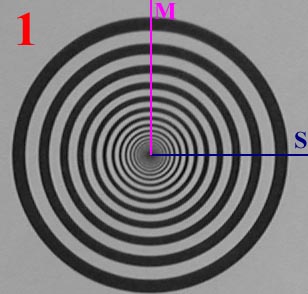  The graph shows how brightness of pixels depends on the distance from the center of the resolution chart. Now we can draw a graph of contrast vs. frequency.  The MTF depends on the direction of strokes. It is connected with astigmatism of the optical system. AstigmatismThe below scheme clarify the phenomenon of astigmatism. 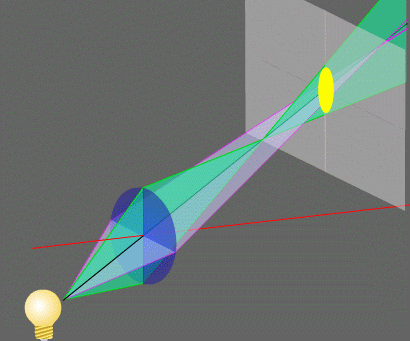 Rays of the same sheaf, coming in meridian and sagittal sections after being refracted by the optical system do not gather in one point. When the lens is in a position optimal for rays laying in a meridian section (a meridian focus), a resolution chart that consists of concentric circles whose centers coincide with a center of a frame will be sharp. And when rays laying in a sagittal section are focused, a sharp resolution chart will consist of strokes going from a frame's center. But we should use data of several points to define characteristics of the MTF of the whole image. We estimated the contrast change at the predetermined frequency for charts located at different distances from the center of the frame. The abscissa axis shows the ratio of the distance from the frame's center to a chart, to a half-width of the frame.  The stroke's width in the examined images of the chart is 6 pixels at the lens focal length equal to 58 mm and 5 pixels at 5.9 mm. All shots are taken at the aperture equal to F:8. Letter s marks the dependence for strokes directed along a radius, and m- at the right angle to it. In order to distinguish influence of the optical system and the matrix on the results we make measurements both for strokes whose direction coincides with rows of sensing elements (marked with figure 3 in the test table), and for those which go diagonally to them (marked with letter d on graphs, and with figure 2 in the test table). 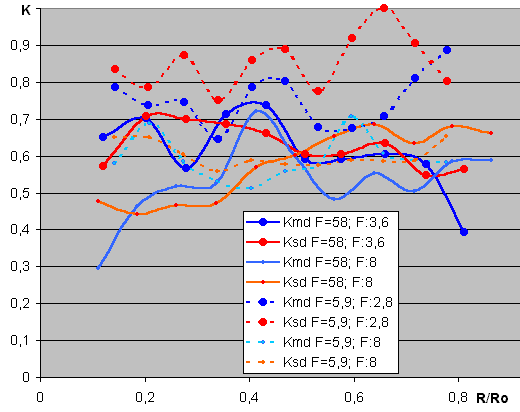 You can see that astigmatism badly affects the image, and the distortions that it brings in here depend on the lens focal length. At the maximum focal length the resolution in the center of the frame is less than on edges. It can be connected both with the optical system and with the fact that the autofocusing system has put the lens into a position when the maximum resolution is on the edges of the frame. Unfortunately, the resolution of the LCD doesn't allows us to manually focus an image in the center of the frame so that it will be good. Anyway, it is important that a contrast of an image depends on a direction of strokes, their position in the frame and a lens focal length. The results show that an element which limits the possibilities of the camera is the lens, though the matrix also makes contributions in the distortion of an image. But it is only qualitative estimation. To determine a quantitative estimate is a baffling problem since we measure the MTF not separately for the lens, but for the system 'lens + matrix', and an algorithm of image processing by camera makes a strong effect on the results. In each point we read a signal only for one of major colors, and then calculate for other colors. Besides, any camera uses an algorithm of sharpness enlargement; and it may cause paradoxical effects. Try to apply a filter "sharpness on edges" in a graphics editor to an image of a radial chart, and you will get a higher contrast for high frequencies. Chromatic aberrationThe matrix is not isotropic. It has dedicated directions: they are rows with sensing elements and filters in front of them. You can see that when shooting charts whose strokes coincide in direction with rows of sensing elements chromatic aberrations get stronger at the expense of the matrix structure. If an edge gets on a matrix cell, sensitive to the relative color, the chromatic aberrations get stronger. When strokes are located diagonally, the contribution of chromatic aberrations is well noticeable, but it doesn't intensify with the matrix structure.  The images are enlarged 4 times. There are fragments which are marked with figures 2 and 3 in the test table. ConclusionIn my opinion, the developers have reached a good compromise between characteristics of the lens and the matrix. The camera is equipped with viewfinders which allow for a comfortable work both indoors and in the sunny weather. A 10x focal length makes the camera quite universal, although for the most of tasks a shorter focal length is preferable. PhotoF=5.9 mm   F=58 mm 
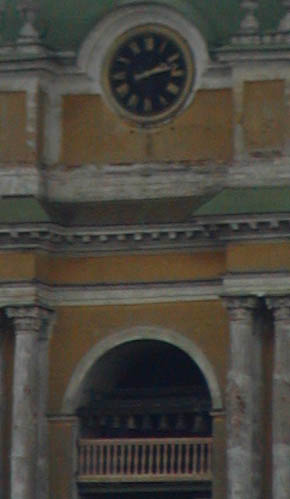 Technical characteristics
Write a comment below. No registration needed!
|
Platform · Video · Multimedia · Mobile · Other || About us & Privacy policy · Twitter · Facebook Copyright © Byrds Research & Publishing, Ltd., 1997–2011. All rights reserved. |